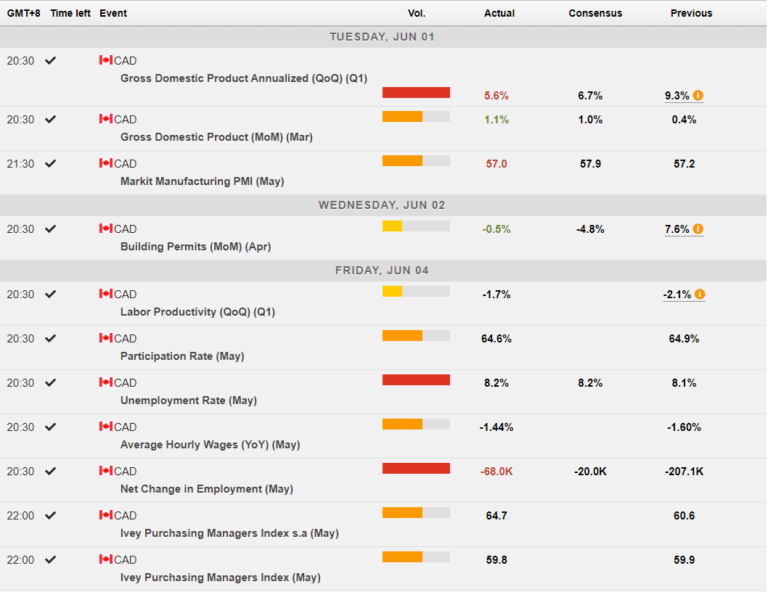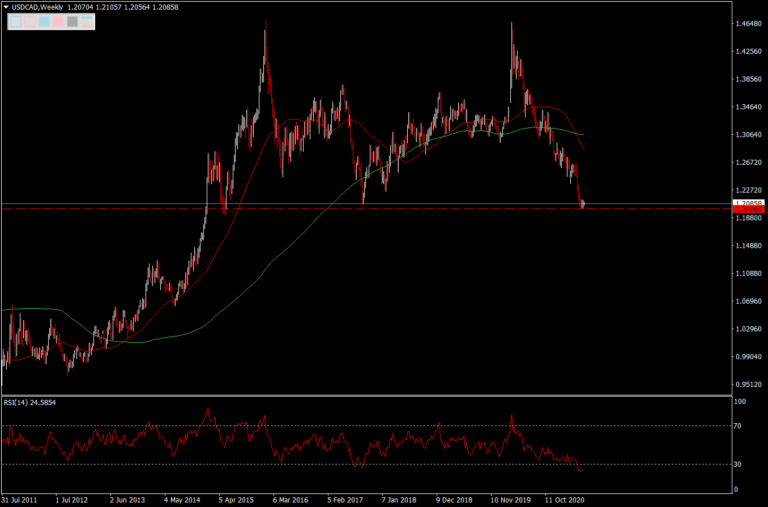The focus on mixed NFP data as well as US inflation data this week will be followed by the ECB (Thursday) and FOMC (16 June) policy meetings. The Canadian Dollar (CAD) is one of the currencies seen to have the potential to move briskly this week. The Bank of Canada (BoC) is expected to hold a currency policy meeting on Wednesday (9 June) and the results are expected to be announced at 14:00 GMT.
Last April, the BoC was the first major central bank to announce they were cutting allocation rates for their Quantitative Easing (QE) program. The BoC reduced the total allocation for asset purchases to CAD $3 billion a week from an initial allocation of CAD $4 billion a week starting late April 2021. BoC Governor Macklem also said that they would keep interest rates low until confident the economy has returned to strength.
Although the BoC was seen as rather positive (hawkish) at last April’s meeting, investors are somewhat worried about the possibility that the BoC will change their tone at this week’s June 9 meeting following poor Canadian labor sector data, where it recorded a job reduction of 207,000 in April followed by 68,000 job losses in May. Meanwhile, the unemployment rate rose to 8.2% in May from 7.5% recorded in March 2021. The chances of the BoC changing their intonation are very slim but any unforeseen circumstances cannot be ruled out. Canada’s first quarter GDP data also failed to meet consensus projections where it recorded economic growth of 5.6% (consensus 6.7%), with data from the previous quarter also revised lower to 9.3% (data before revision 9.6%). As such, the BoC is not expected to change interest rates but any comments from the BoC regarding the economy are expected to provide volatility to the market.
USDCAD has continued to remain on a downward trend over the past 15 months, declining 18% since its March 2020 high.
Fundamentally, USDCAD is expected to be pressed downwards due to currency policy differences between the two Central Banks where the FED is still in dovish intonation while the BoC is starting to look a bit hawkish. Investors have yet to get any catalyst (hawkish statement from the FOMC FED) for a possible rebound of the USDCAD. A Goldman Sachs source also reportedly said that the risks to CAD weakness are limited despite slightly weaker Canadian economic data in the 2nd quarter of 2021. Analysts at ING also saw the BoC be slightly neutral at the June policy meeting (no surprises) and they are expected to cut allocations for Weekly QE at the July meeting.
From the point of view of intermarket analysis, the strengthening of commodity prices and WTI oil prices (USOil) is expected to continue to support the strength of the CAD where 11% of Canada’s GDP is contributed from commodities and oil. The dynamics between oil prices and CAD is expected to remain in line in the near future.
USDCAD momentum is expected to continue to decline with the 1.2000 level being an important support for the Bulls to survive. If this level is broken, it will open the door for USDCAD to trade below the 1.2000 level for the first time since May 2015. However, USDCAD is also likely to move in a horizontal position for the near future between 1.2000 and 1.2150. With US inflation data this week it may be able to withstand the fall of the USDCAD post the BoC meeting.
Disclaimer: Nothing in this communication contains, or should be considered as containing, an investment advice or an investment recommendation or a solicitation for the purpose of purchase or sale of any financial instrument.
Recommended Content
Editors’ Picks

EUR/USD falls back toward 1.1150 as US Dollar rebounds
EUR/USD is falling back toward 1.1150 in European trading on Friday, reversing early gains. Risk sentiment sours and lifts the haven demand for the US Dollar, fuelling a pullback in the pair. The focus now remains on the Fedspeak for fresh directives.

GBP/USD struggles near 1.3300 amid renewed US Dollar demand
GBP/USD is paring back gains to trade near 1.3300 in the European session. The data from the UK showed that Retail Sales rose at a stronger pace than expected in August, briefly supporting Pound Sterling but the US Dollar comeback checks the pair's upside. Fedspeak eyed.

Gold hits new highs on expectations of global cuts to interest rates
Gold (XAU/USD) breaks to a new record high near $2,610 on Friday on heightened expectations that global central banks will follow the Federal Reserve (Fed) in easing policy and slashing interest rates.

Pepe price forecast: Eyes for 30% rally
Pepe’s price broke and closed above the descending trendline on Thursday, eyeing for a rally. On-chain data hints at a bullish move as PEPE’s dormant wallets are active, and the long-to-short ratio is above one.

Bank of Japan set to keep rates on hold after July’s hike shocked markets
The Bank of Japan is expected to keep its short-term interest rate target between 0.15% and 0.25% on Friday, following the conclusion of its two-day monetary policy review. The decision is set to be announced during the early Asian session.

Moneta Markets review 2024: All you need to know
VERIFIED In this review, the FXStreet team provides an independent and thorough analysis based on direct testing and real experiences with Moneta Markets – an excellent broker for novice to intermediate forex traders who want to broaden their knowledge base.


